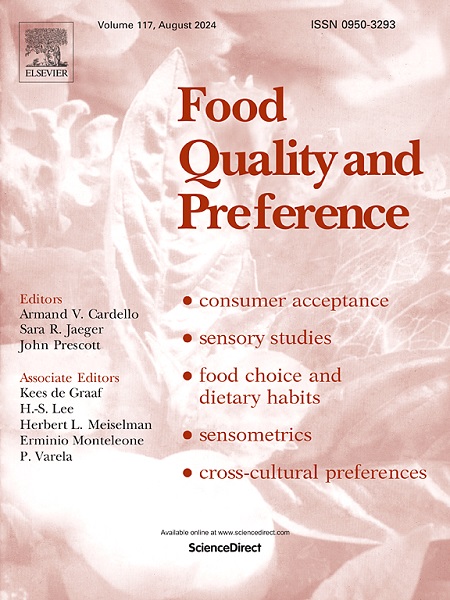Investigating the effect of animal visualisations on meat choice: An experimental lab study with a fake food buffet
IF 4.9
1区 农林科学
Q1 FOOD SCIENCE & TECHNOLOGY
引用次数: 0
Abstract
High rates of meat consumption have negative effects on health and the environment. Various studies have shown that visualising animals (e.g., through photos of animals placed next to meat products) can induce cognitive dissonance and reduce the intention to consume meat. However, almost all of these previous studies were conducted in online settings. Therefore, the present study investigates the effect of animal visualisations on meat choices in an experimental lab study at a fake food buffet. We used a between-subjects design with three conditions: realistic images (n = 107), schematic images (n = 107), and no images (n = 107). As the dependent variable, we compared the proportion of meat that participants selected from the fake food buffet. Contrary to our pre-registered hypotheses, we found no differences in meat selection, neither between the animal visualisation conditions compared to the control group, nor between the realistic and the schematic image condition. Moreover, we found no support for a mediating effect of cognitive dissonance. We conclude that animal visualisations are less effective in realistic settings than in online studies.
研究动物形象对肉类选择的影响:一项关于假自助餐的实验实验室研究
高肉类消费量对健康和环境有负面影响。各种研究表明,可视化动物(例如,通过放置在肉类产品旁边的动物照片)可以引起认知失调,减少消费肉类的意图。然而,几乎所有这些先前的研究都是在网上进行的。因此,本研究调查了动物视觉对肉类选择的影响,在一个实验实验室研究中,在一个假的食物自助餐。我们采用了三种条件下的受试者间设计:真实图像(n = 107)、示意图图像(n = 107)和无图像(n = 107)。作为因变量,我们比较了参与者从假自助餐中选择的肉的比例。与我们预先登记的假设相反,我们发现动物可视化条件与对照组相比,在肉类选择上没有差异,也没有在现实和示意图图像条件之间存在差异。此外,我们没有发现认知失调的中介作用的支持。我们得出的结论是,动物可视化在现实环境中的效果不如在线研究。
本文章由计算机程序翻译,如有差异,请以英文原文为准。
求助全文
约1分钟内获得全文
求助全文
来源期刊

Food Quality and Preference
工程技术-食品科技
CiteScore
10.40
自引率
15.10%
发文量
263
审稿时长
38 days
期刊介绍:
Food Quality and Preference is a journal devoted to sensory, consumer and behavioural research in food and non-food products. It publishes original research, critical reviews, and short communications in sensory and consumer science, and sensometrics. In addition, the journal publishes special invited issues on important timely topics and from relevant conferences. These are aimed at bridging the gap between research and application, bringing together authors and readers in consumer and market research, sensory science, sensometrics and sensory evaluation, nutrition and food choice, as well as food research, product development and sensory quality assurance. Submissions to Food Quality and Preference are limited to papers that include some form of human measurement; papers that are limited to physical/chemical measures or the routine application of sensory, consumer or econometric analysis will not be considered unless they specifically make a novel scientific contribution in line with the journal''s coverage as outlined below.
 求助内容:
求助内容: 应助结果提醒方式:
应助结果提醒方式:


